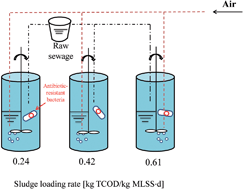The sludge loading rate regulates the growth and release of heterotrophic bacteria resistant to six types of antibiotics in wastewater activated sludge†
Abstract
Wastewater treatment plants are considered as hot reservoirs of antimicrobial resistance. However, the fates of antibiotic-resistant bacteria during biological treatment processes and relevant influencing factors have not been fully understood. This study evaluated the effects of the sludge loading rate on the growth and release of six kinds of antibiotic-resistant bacteria in an activated sludge system. The results indicated that higher sludge loading rates amplified the growth of all six types of antibiotic resistant bacteria. The release of most antibiotic-resistant bacteria through both the effluent and biosolids was amplified with increased sludge loading rate. Biosolids were the main pattern for all antibiotic-resistant bacteria release in an activated sludge system, which was determined primarily by their growth in the activated sludge. A higher sludge loading rate reactor tended to retain more antibiotic resistance. An activated sludge system with lower sludge loading rates was considered more conducive to the control of antibiotic resistance.


 Please wait while we load your content...
Please wait while we load your content...